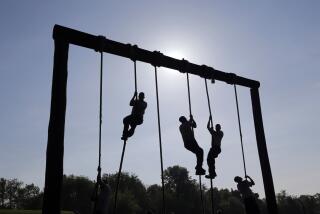Navy in New Role but Challenge Is Same
- Share via
The Maine, 1898. The Panay, 1937. The Liberty, 1967. The Pueblo, 1968. The Mayaguez, 1975. All recall “incidents” involving American ships in which American lives were lost.
To this list we now add the Stark, 1987. The pain returns. The old frustration resurfaces. The searching questions are asked again. The hawks demand direct action. The doves want to pull out. And the rest of us feel vaguely guilty when we hear the critics trumpet that old chestnut, “gunboat diplomacy.”
Meanwhile, the Navy stays on the job.
Though the Constitution’s framers exactly 200 years ago allowed for a Navy, the peace-loving Americans waited until 1798 to create one. Even the great liberal Thomas Jefferson conceded the necessity for gunboats to protect the American coast. But in 1801-1805 he found himself having to send sailing frigates to the Mediterranean to forcibly stop the Barbary pirates from plundering American merchantmen.
And so it has been ever since. To make the world safe not only for democracy, as Woodrow Wilson put it, but also for the traded manufactures that Founding Father Alexander Hamilton believed essential to our prosperity, the Navy has remained an essential tool of national policy and diplomacy.
Although the United States did employ gunboats in the Caribbean and Far East early in the present century, it preferred the more mobile frigates--powered by sail, then steam and now gas turbines. These versatile ships enforced free and unfettered trade in 1805, just as they do in 1987. Today’s exported oil of the Persian Gulf region is essential to the very survival of industrialized Western Europe and Japan, our major political, economic and military partners. Like the frigate Constitution--”Old Ironsides”--sailing into Tunis in 1805, the frigate Stark and her sisters carry on today.
Not until Theodore Roosevelt took office 100 years after Jefferson, however, did any American President fully articulate the role of the United States and its Navy in the shrinking globe.
Addressing the graduating midshipmen at Annapolis in 1905, he declared that this country had “to do its duty on the side of civilization, on the side of law and order. . . . What we desire is to have it evident that this nation seeks peace, not because it is afraid, but because it believes in the eternal and immutable laws of justice and of right living.”
Then, looking at the future naval officers before him, he announced, “One of your greatest duties is to see that shots hit!”
T.R. appreciated the strategic reality that the United States is a maritime nation, a continent-size island without enemies on its borders. Like mother Britain, it is a democracy that has always depended on free enterprise at home and abroad. And throughout the 19th Century, its overseas trade was guaranteed by the international law and maritime order enforced by the Royal Navy--the Pax Britannica , or peace of Britain.
The British endeavored to use their immense naval power with restraint and wisdom. They became highly professional keepers of the peace whose “shots hit.” Britain sought to deter two types of outlaws--great-power aggressors on the one hand and pirates, slavers, smugglers and local war lords on the other.
But two world wars left Great Britain prostrate as a great power. America has no real choice, if international law is to be perpetuated, but to fill the vacuum left by Britain’s withdrawal--in Europe, the FarEast, on the high seas, in the Persian Gulf.
Instead of battleships, today we have ballistic-missile submarines facing the Soviet Union. Rather than gunboats we use aircraft carriers, destroyers and frigates.
We are the ones now who enforce the peaceful intercourse of nations, a heritage deeply rooted in our cherished democratic institutions. This is the “peace” of American supremacy at sea, the Pax Americana.
Preoccupied with the Soviet menace, however, our national power and thus our maritime strategy have been oriented primarily to the great-power dimension of deterring aggression. Only very recently has the Navy begun to refine and extend its maritime strategy by looking systematically at the demands of making “shots hit” in the trouble spots of the world. Constant patroling of Third World waters and of countering international terrorism require a professional competence as important as that of fighting a great sea battle with the Soviet Navy.
Thus the U.S. Navy’s policy-makers and strategic thinkers will convene next month in their annual Current Strategy Forum at the Naval War College in Newport, R.I. The topic for discussion will be “Maritime Power in an Era of Violent Peace,” a theme chosen months ago, long before the lives of more than three dozen American sailors were snuffed out on the Stark in the Persian Gulf.
The Navy’s counterparts in the State Department and in the Army and Air Force--and indeed the university community--will do well to listen to what the Navy has to say. For it is in the Navy where the real expertise lies for maintaining the peace on and adjacent to the waterways of the world.
The reality that Adm. Harold R. Stark, chief of naval operations on the eve of World War II, faced in preparing the Navy to fight the fascist outlaws of an earlier era, is not unlike that which his namesake ship experienced last Sunday.
Adm. Stark’s surprise was Pearl Harbor, that of the frigate Stark an Iraqi missile. Only eternal vigilance can minimize surprises of any magnitude. And only a Navy that is highly professional in all the missions assigned it can guarantee that its shots will hit.
More to Read
Sign up for Essential California
The most important California stories and recommendations in your inbox every morning.
You may occasionally receive promotional content from the Los Angeles Times.













